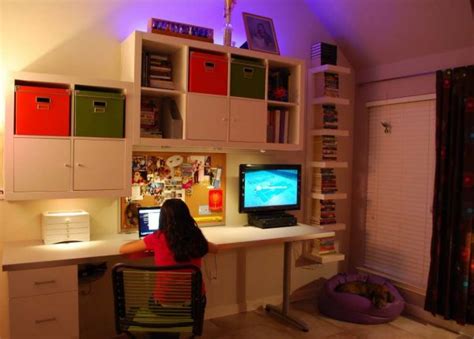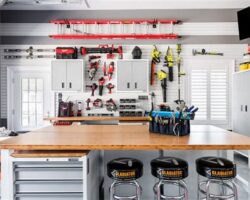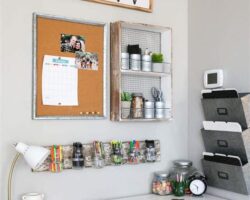Designing a home office specifically for a teenager can be a challenging yet exciting project. It requires a careful balance between functionality and style to create a workspace that meets the unique needs of a young user. In this blog post, we will explore the key elements of designing a teen-friendly home office that is both functional and stylish. From understanding the needs of teenage users to choosing the right furniture and accessories, we will discuss how to create a productive and comfortable workspace that reflects the teenager’s personality. We will also delve into incorporating trendy and stylish design elements, optimizing storage solutions, and integrating technology for connectivity and productivity. By the end of this post, you will have a clear understanding of how to design a home office that not only meets the practical needs of a teenager but also reflects their individuality and style.
Understanding the needs of teenage users
Teenagers are a unique demographic with specific needs when it comes to their living spaces. Understanding these needs is crucial in creating a functional and comfortable environment for them.
Privacy is a key concern for many teenagers. They value their personal space and require areas where they can retreat and have time to themselves.
Additionally, flexibility is important. Teenagers often have changing interests and activities, so a space that can adapt to their evolving needs is essential.
Comfort is also a top priority. Teenagers need comfortable furniture and accessories that support their physical and emotional well-being.
Creating a productive and comfortable workspace
When designing a workspace for a teenager, it is essential to prioritize productivity and comfort. The workspace should be free from distractions and conducive to focusing on tasks. This can be achieved by choosing a quiet location in the house, away from high-traffic areas. Additionally, it’s important to invest in a comfortable chair and desk to support good posture and prevent fatigue during long study or work sessions.
Furthermore, incorporating ergonomic furniture and accessories can contribute to creating a space that promotes overall well-being. Adjustable desk heights, keyboard trays, and monitor arms can help customize the workspace to the teenager’s specific needs, reducing physical strain and discomfort.
Lighting also plays a crucial role in creating a productive workspace. Natural light is ideal, so positioning the desk near a window can provide ample light and a connection to the outdoors. In the absence of natural light, investing in task lighting that can be adjusted for brightness and direction is important to reduce eye strain and create a comfortable environment for studying or working.
In conclusion, a productive and comfortable workspace for a teenager should prioritize minimal distractions, ergonomic furniture, and adequate lighting. By considering these factors, the designated workspace can become a place where the teenager can thrive and achieve their academic and personal goals.
Choosing furniture and accessories for functionality
When designing a teenager’s living space, it’s important to prioritize functionality when it comes to choosing furniture and accessories. Teenagers need a space that not only looks good but also serves their everyday needs, from studying to relaxing and socializing.
When it comes to furniture, opt for pieces that are multi-functional, such as a bed with built-in storage drawers or a desk with shelving and compartments. This allows the teenager to keep their space tidy and organized, while also maximizing the limited space available in most teenage bedrooms.
Accessories should also be chosen with functionality in mind. Look for items that serve a purpose, such as desk organizers, a comfortable desk chair that provides proper support for studying, and adequate lighting for reading and working. By choosing accessories that enhance the usability of the space, you can ensure that the teenager’s room is both stylish and practical.
Consider also the durability and ease of maintenance of the chosen furniture and accessories. Teenagers are often busy with school, extracurricular activities, and socializing, so their living space should be easy to maintain and clean. Opt for materials that are easy to wipe down and are resistant to wear and tear.
Incorporating trendy and stylish design elements
When designing a space for teenage users, it’s important to incorporate trendy and stylish design elements that reflect their personal tastes and preferences. This can include using bold and vibrant colors, modern furniture pieces, and eye-catching accessories that add personality to the room.
One way to incorporate trendy design elements is to use statement pieces such as a unique lighting fixture, an accent wall with a bold wallpaper, or a piece of furniture with an unexpected shape or color. These elements can help to create a visually striking and modern space that appeals to teenage users.
Additionally, consider incorporating trendy patterns and textures such as geometric shapes, metallic accents, and textured fabrics. These can add depth and visual interest to the room, making it feel more youthful and on-trend.
Finally, be mindful of incorporating stylish design elements that can grow and evolve with the teenage user. Choose pieces that are versatile and can be easily updated as their tastes change, ensuring that the space remains relevant and appealing for years to come.
Optimizing storage solutions for a clutter-free environment
When it comes to creating a clutter-free environment, optimizing storage solutions is key. By maximizing the use of available space and incorporating functional storage options, you can ensure that the area remains organized and tidy.
One way to optimize storage solutions is by utilizing multi-functional furniture pieces. For example, a bed with built-in drawers or a desk with shelving can provide additional storage without taking up extra space.
Another strategy is to make use of vertical storage options such as wall-mounted shelves, hanging organizers, and tall bookcases. This not only helps to maximize storage capacity but also keeps items off the floor, creating a more open and spacious feel to the room.
Additionally, incorporating hidden storage solutions, such as ottomans with hidden compartments or coffee tables with lift-up tops, can help to keep clutter out of sight while still maintaining easy access to everyday items.
Integrating technology for connectivity and productivity
In today’s world, technology is an essential part of our daily lives. When designing a space for teenagers, it’s important to consider how to integrate technology in a way that enhances connectivity and productivity. One way to achieve this is by ensuring that the workspace has adequate electrical outlets and USB ports to accommodate the various devices that teenagers use. This will allow them to easily charge their devices while working, keeping them connected and productive.
Another way to integrate technology for connectivity and productivity is by incorporating smart home automation systems into the design. This could include smart lighting, thermostats, and even voice-activated assistants. By automating certain aspects of the space, teenagers can focus more on their tasks and less on the mundane aspects of living in the space.
Additionally, providing ergonomic and versatile furniture that can accommodate technology such as laptops and tablets is crucial. Adjustable desks and chairs, as well as cable management systems, can help create a clutter-free environment that promotes efficiency and focus.
Lastly, the design should also take into account the need for a reliable internet connection. High-speed Wi-Fi is vital for teenagers to stay connected, conduct research, and communicate with others. Therefore, when designing the space, it’s important to ensure that the internet connectivity is strong and reliable throughout the entire area.
Designing a space that reflects the teenager’s personality
When designing a space for a teenager, it’s important to consider their unique personality and preferences. Personalization is key in creating a space that truly reflects the teenager’s individuality. This can be achieved through the use of color palettes that the teenager loves, incorporating their favorite furniture pieces, and showcasing their cherished decor items.
It’s also important to consider the teenager’s hobbies and interests when designing their space. For example, if they are a music lover, incorporating a dedicated space for their musical instruments or a wall display for their favorite records can make the room feel personalized and reflective of their passions.
Another important aspect to consider is the teenager’s need for privacy and personal space. Providing them with a designated area for study, relaxation, and self-expression can contribute to a sense of ownership and comfort in their environment.
Lastly, involving the teenager in the design process and allowing them to have a say in the decor choices and layout of the room can ensure that the space truly reflects their personality and makes them feel at home.





